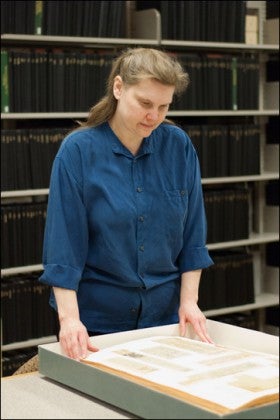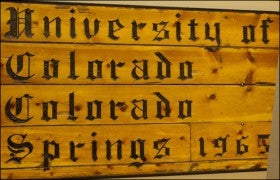Five questions for Mary Rupp
Mary Rupp spent a lot of time in libraries throughout her life, but it wasn't until she worked in the Learning Resource Center at a community college she attended that she understood the full scope of library work and what she wanted to do for a living.
While attending library school, she realized she had an aptitude for smaller collections with more narrow focus. She chose to specialize in areas that included instruction on rare books and archival materials as well as online databases and specialized reference sources.
"Of course, one's career path is rarely what one expects. After graduating with my master's in library science degree, I next found myself working in the general collections and with new technology. It was not what I expected but helped me gain skills that through time have become more integrated with the care and use of materials in specialized collections," Rupp says.
Rupp is the archives librarian and digital repository coordinator at the UCCS Archives, Kraemer Family Library at the University of Colorado Colorado Springs.
In the UCCS Archives, where she has worked since 2009, she has a range of duties: from acquiring, arranging (organizing the materials within collections) and describing (creating the records within the archives information system), to processing (physically organizing the materials) and preserving the materials themselves. She also creates "finding aids" that describe and provide context for the collections and assist researchers in finding and using the materials in the archives.
The library also is developing a digital repository in association with the libraries of other institutions. Currently she works with representatives of other institutions to develop policies and procedures for the system as it affects all the collections. In addition, she works on the reference desk of the Kraemer Family Library providing assistance to library users.
Before coming to UCCS, Rupp worked as a reference librarian in public and academic libraries, and in corporate and school libraries, and provided computer support for a nonprofit. All of the positions have combined information management – collecting, organizing, analyzing, storing and retrieving information – with customer service.
She says few people on campus know about the archives, what it contains and how it can be useful, but she's working to change that. A current library exhibit – "History of the Library at UCCS" – showcases archival materials.
— Cynthia Pasquale
1. The "History of the Library at UCCS" exhibit traces the challenges of establishing the library. Explain some of the challenges and why did you choose this topic for an exhibit?
The University of Colorado Colorado Springs campus developed from the University Extension Center in Colorado Springs. A small library collection existed when the campus was founded on the property acquired from the Cragmor Sanatorium (originally for tuberculosis patients). The collection was made up of books donated by instructors of the Extension Center courses and a local military officer's group, as well as books from the Sanatorium library. The exhibit traces the challenges of the library to grow its collection, facilities, and services on the growing campus.
My challenges were to make the History of the Library at UCCS understandable and visually interesting. Photographs of the library and descriptions of different settings provide a sharp contrast to current facilities and resources. Materials from a variety of sources were used – original floor plans for buildings that have since been demolished or renovated, articles from the student newspaper for contemporary views, and library handouts and documents describing services. Together they describe the library and its interaction with all parts of the campus through time.
Topics of the UCCS Archives exhibits are always some aspect of the history of the Colorado Springs campus. The history of the library will be a two-part display. The first part of the exhibit covers the years 1956-1995 and includes information about library services at the Extension Center. The second part of the exhibit covers the years 1996 to present and will be on display in April, which coincides with the 15th anniversary of the naming of the Kraemer Family Library.
The exhibits provide historical information for the faculty, staff and students of the rapidly changing campus. The physical facilities and the student population of the campus have changed greatly in the last 20 years and more people are looking at "why are things this way?" The exhibits attempt to provide some of that information.
2. What are some of the most interesting and most requested items in the archives?
The UCCS Archives strives to collect materials documenting the history of UCCS without duplicating the collections of other institutions. Items in the archives are organized in collections relating to the organization of the campus. Documents include reports, communications, office and personal files, and records of events. There are collections of images – photographs, slides, and a small amount of video. Artifacts are a small part of the total collection but vary widely.
On first entering the archives, the most interesting item people see is the first sign for UCCS. The sign is more than 4 feet tall and 8 feet wide and is made of wood. The letters were made with wood-burning equipment then painted by one of the professors of UCCS and his father-in-law in their garage. This sign was the first to be put next to the road leading to the campus that identified the campus as the University of Colorado Colorado Springs.
The most requested materials in the UCCS Archives are the student newspapers. The collection contains newspapers going back to the establishment of the paper in 1966. They give a students' perspective on events, something that has been difficult to find on a longtime commuter-only campus. There are a few issues missing so I am always looking for additional issues.
3. What goals do you have for the UCCS Archives? Are there other projects coming up besides this exhibit?
Growth – increasing materials in collections and their use – is my main goal for the UCCS Archives. Increasing awareness of the archives is an ongoing process that will continue. Internal projects to improve collection management and searching mechanisms are planned through this year, as are identifying points of intersection with the digital repository.
Exhibits are a primary part of the education and outreach efforts of the UCCS Archives. I have been doing several large exhibits per year with up to six smaller displays of shorter duration with fewer items and less description. Upcoming temporary displays will focus on commencement and convocation. There will be larger exhibits on student government in the fall and the campus police department in the spring of next year.
I like the constant challenge of my job. Not only am I making the materials accessible to and helping the researcher use them but I am constantly building the collection as well. I am continually finding information – learning the history of the campus, finding out what the significance of an item might be, understanding its place in the collection – and putting it into the record so that information is available.
4. What do you consider the archive's most important aspect and role?
The unique nature of archives holdings requires special handling and specific procedures for access. The materials include primary sources – materials created through the operating processes of the university that document daily business and important events – and other materials that have been recognized as containing information worth preserving. These materials are maintained and used for research on the history of the campus as well as research with broader applications, such as comparison with similar institutions or aspects of college life across a variety of institutions.
The most important role and the greatest challenge for the archives are to preserve these materials and make them accessible to researchers. Archives preserve materials by creating a controlled environment to house the materials. Materials are kept in protective containers – generally acid-free boxes and folders for documents and supportive containers with padding for other objects. Physical access is restricted in how and when the materials can be used to protect unique and sometimes fragile objects and documents.
While protecting the materials, archives make them accessible. New technologies and methods – particularly digitization of images – allow wider access to some materials by creating a representation that can be used by a remote researcher and sometimes in place of the fragile original.
Like all those working with archives, I am faced with the questions of choosing techniques for long-term preservation and weighing the possibilities of loss of information from the choice.
In many cases, new technologies are being used by the world and the archives must find a way to preserve the information contained in those technologies and their media which may be obsolete before they are needed for research. For instance, the tapes of data for the Apollo missions are difficult or impossible to access because the programs for reading them have been lost as have the previous e-mail system or content management system for the website. A component of preservation is assuring accessibility so the information can be studied.
5. What are some of your favorite activities outside your archives work?
I took up gardening after I moved to Colorado. I have determined that is because I like a challenge – especially since I lived in a place where the challenge was keeping things from growing in the constant moisture. My garden is small but I enjoy experimenting with heirloom vegetables and flowers (many of which do not grow here).
Gardening led me to beekeeping. When the first reports of Colony Collapse Disorder began to be widely circulated, I realized that I had never paid attention to whether there were bees around the garden or not. I thought I could set up a hive, ensure pollination, and encourage local bees. It is never as easy as it theoretically sounds. Now I have two hives and that is plenty to keep me busy and keep me from using pesticides in the garden.
Then there is the quilting. I have always done some sewing but the majority recently has been making lap quilts for the Quilts of Valor organization (http://www.qovf.org/) which distributes the quilts to "service members and veterans touched by war." We got a group of unsuspecting people to make quilt blocks and we have continued to make quilts that have been sent to wherever they are needed.



